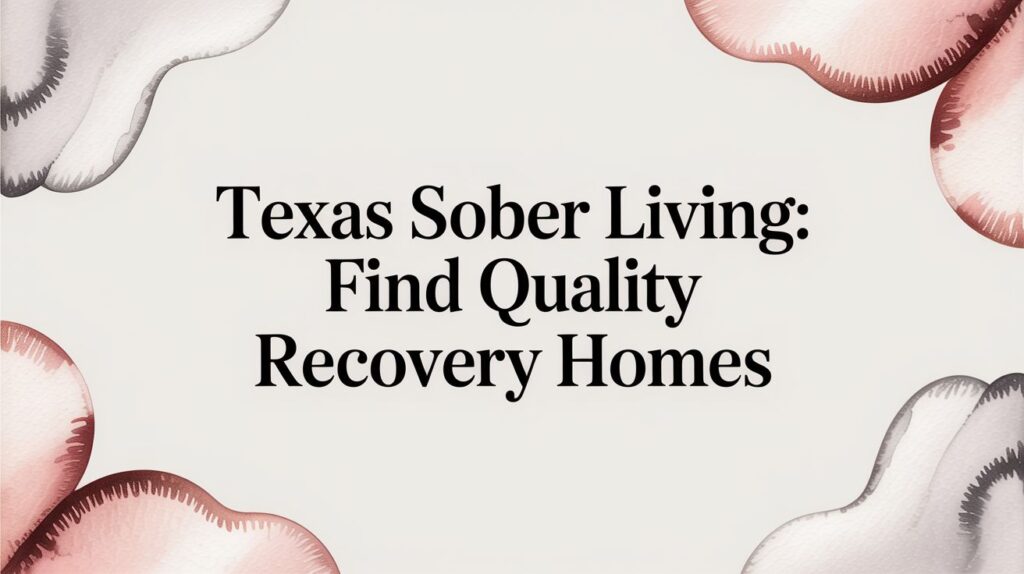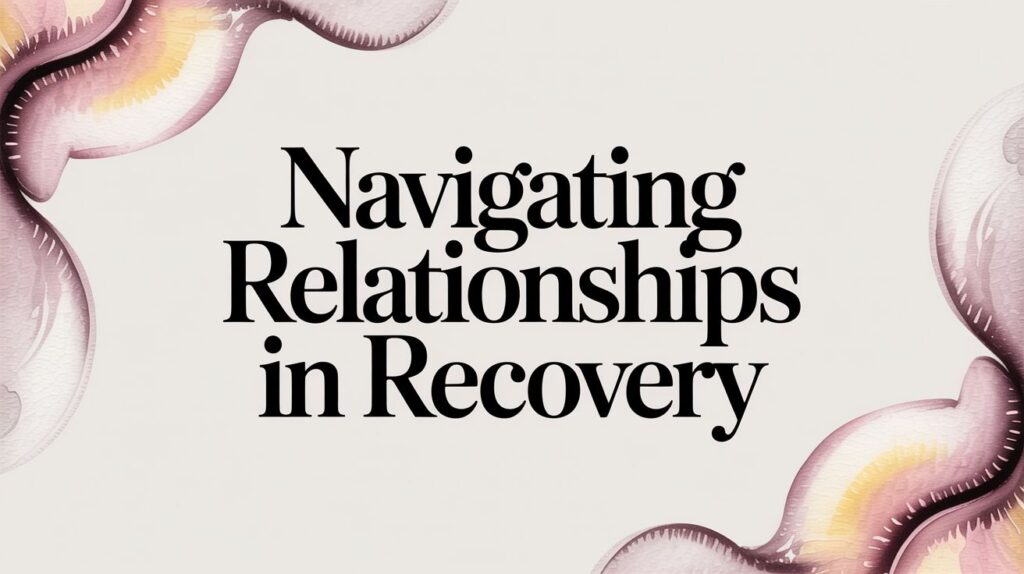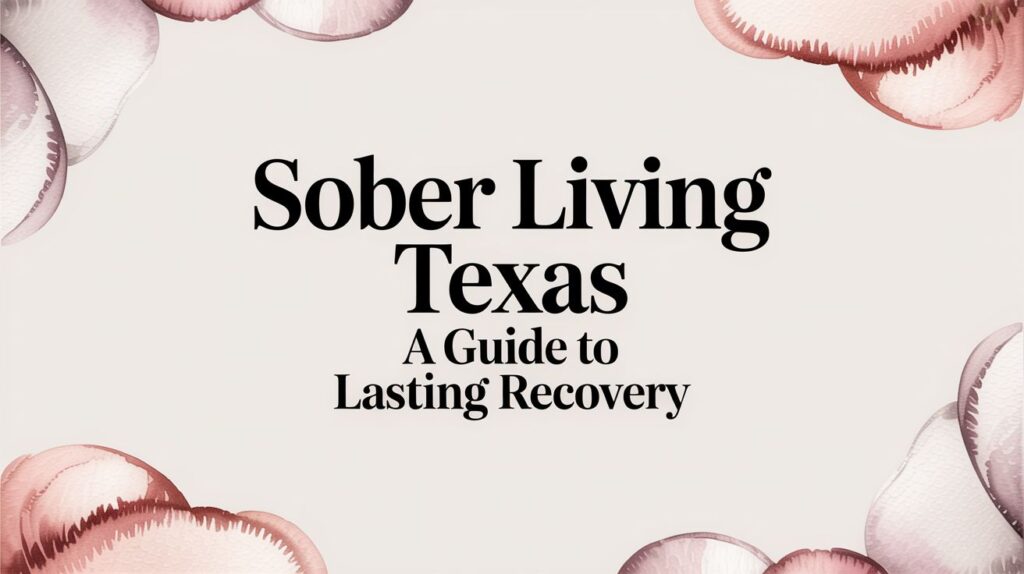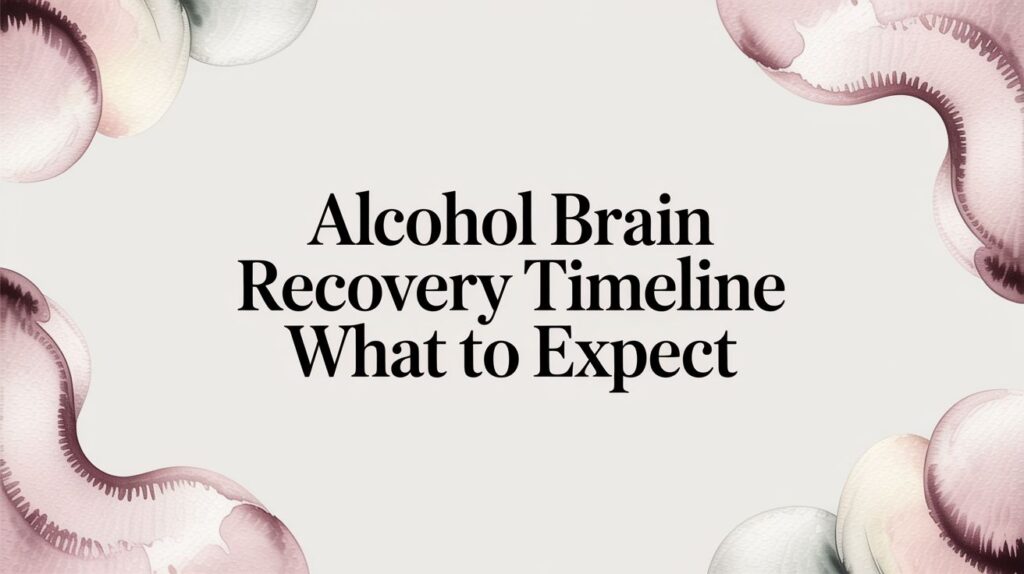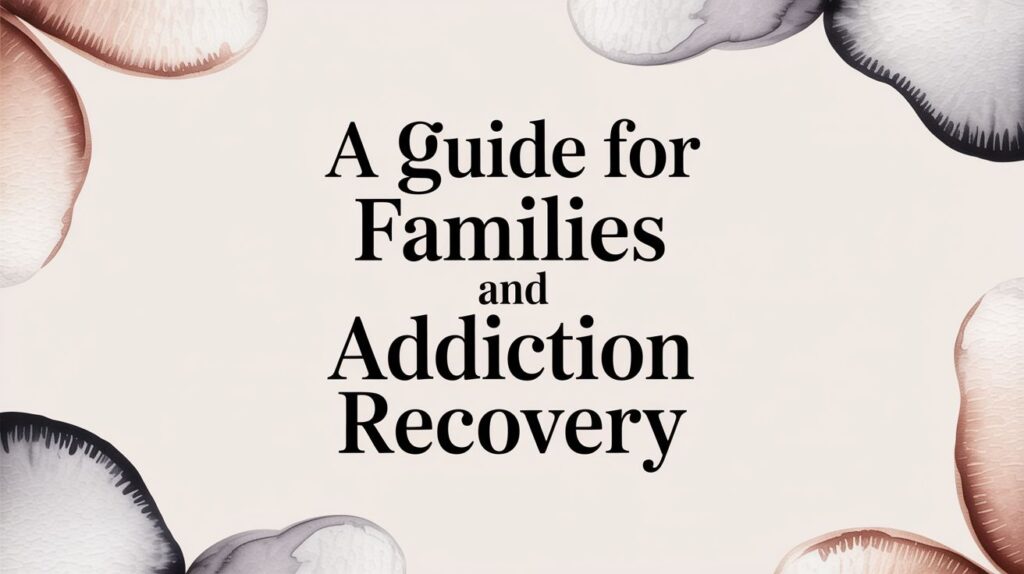A Texas sober living home is more than just a place to stay—it's a structured, substance-free residence designed to be a critical bridge between formal addiction treatment and a return to independent life. It creates a supportive environment where you can practice new recovery skills, build real accountability, and connect with peers who are just as dedicated to sobriety as you are.
Think of this model as the essential step that helps solidify new, healthy habits in a real-world setting, but with a crucial safety net still in place.
Your Bridge to Lasting Recovery

Walking out of a highly structured inpatient rehab facility can feel like stepping off a cliff. That sudden shift back into daily life—with all its old triggers and new pressures—is one of the most vulnerable times in anyone's recovery journey. This is precisely where a Texas sober living home steps in to provide life-saving support.
It’s best to see it as a training ground for a new way of living. Just as an athlete runs drills before the championship game, residents in a sober living home get to practice the skills they learned in treatment every single day. They learn to navigate jobs, relationships, and responsibilities without turning to drugs or alcohol, all while being backed by a community that gets it.
Sober Living Homes vs Inpatient Rehab
It’s common to confuse sober living with inpatient rehab, but they serve very different purposes in the recovery timeline. Rehab is where you go to get stabilized and learn the core skills; sober living is where you go to practice them.
This table breaks down the key differences:
| Feature | Inpatient Rehab | Texas Sober Living |
|---|---|---|
| Primary Goal | Medical stabilization, intensive therapy, and initial skill-building. | Practicing recovery skills, building accountability, and reintegrating into daily life. |
| Clinical Services | 24/7 medical and clinical supervision, daily individual and group therapy. | Peer support and accountability; clinical services are typically coordinated with an outside provider (like an IOP). |
| Environment | Highly structured, self-contained, and isolated from outside triggers. | Real-world setting with structured rules, allowing for work, school, and community engagement. |
| Length of Stay | Typically shorter, from 30 to 90 days. | More flexible, often ranging from several months to a year or more. |
| Personal Freedom | Very limited; focus is entirely on treatment activities within the facility. | Greater autonomy, with residents managing their own schedules, finances, and personal responsibilities. |
While both are vital, sober living is the crucial step that helps translate the lessons of rehab into lasting, real-world sobriety.
Creating a Foundation of Accountability
Accountability is the bedrock of the sober living model. Unlike going home to live alone, residents are immediately part of a community with shared goals and crystal-clear expectations.
This structure almost always includes:
- House Rules: Things like curfews, mandatory house meetings, and assigned chores create the routine and responsibility that recovery thrives on.
- Peer Support: Living with others who genuinely understand the daily challenges of recovery fosters a powerful sense of belonging and mutual encouragement that's hard to find anywhere else.
- Regular Drug Testing: This isn't about punishment; it's a non-negotiable requirement that keeps the environment safe and holds everyone accountable to their recovery commitments.
This web of collective responsibility helps residents slowly rebuild trust—both in themselves and in others. It has a way of transforming recovery from an isolated, internal struggle into a shared, manageable journey.
A sober living home isn't just a place to live; it's a place to learn how to live again. It provides the structure and support needed to turn recovery principles into everyday habits.
The Texas Recovery Housing Landscape
Knowing what's available is a huge piece of the puzzle. While the need for high-quality recovery housing is sky-high across Texas, access can vary wildly depending on where you are. This can create a tough situation for people looking for immediate placement and support.
The numbers tell the story. Texas has 583 identified recovery residences, which averages out to just 2.06 residences per 100,000 people. Even more telling, of the state's 254 counties, a staggering 218 have no recovery residences whatsoever. That means about 86% of counties have fewer than five options available. You can dig deeper into these numbers in the National Study of Treatment and Addiction Recovery Residences.
This scarcity makes finding the right fit more critical than ever. A quality home does so much more than offer a roof over your head. It provides the tools, the community, and the safe space necessary to build a rock-solid foundation for lifelong sobriety. It’s a vital step in turning the hope of recovery into a lived reality.
The Real-World Payoff of Structured Recovery Housing
Leaving a treatment facility can feel a lot like learning to walk again after an injury. You're steady inside the hospital walls, but the world outside is full of uneven ground. A structured recovery house in Texas acts as the physical therapy you need to build strength and confidence for that journey. It’s not just about having a roof over your head; it's about rebuilding a life from the studs up, one solid habit at a time.
The practical upsides hit you right away. Daily routines, shared chores, and clear house rules aren't there to hold you back—they're there to clear the path. They help restore the basic life skills that addiction often washes away.
By cutting out the daily chaos that comes with active use, you suddenly have a huge surplus of mental and emotional energy. That newfound bandwidth can finally be directed where it matters most: mending relationships, landing a stable job, or getting back into school.
The Unspoken Power of Peer Support
One of the most potent ingredients in a Texas sober living home is the built-in community. Isolation is rocket fuel for relapse, and these homes are designed to smother that fire by surrounding you with people who just get it.
Living alongside others navigating the same rocky terrain creates an organic support system that's hard to replicate anywhere else. It becomes a place where celebrating small wins is normal and getting a word of encouragement during a rough patch is expected. This kind of peer-to-peer accountability often feels more genuine and immediate than anything you can get in a clinical setting alone.
Here, you learn how to forge new, healthy friendships that are actually rooted in sobriety. That process is absolutely vital for breaking old patterns and creating a lifestyle that can actually sustain long-term recovery.
A Safe Harbor from Triggers and Temptation
A 100% substance-free environment is the non-negotiable bedrock of recovery housing. In early sobriety, willpower is a finite resource, and it’s rarely enough to stand up to the constant barrage of triggers out in the real world. A sober living home acts as a protective buffer, minimizing those risks when you're at your most vulnerable.
This safety gives your brain and body the space they need to heal without the constant, low-grade stress of fighting off temptation. It’s the training ground where you can practice new coping skills before you have to use them under real-world pressure.
A structured sober living home offers more than just rules; it offers relief. By taking care of the environmental safety, it frees you up to focus all your energy on the internal work of recovery.
And the commitment to health goes beyond just the absence of drugs and alcohol. It’s baked into the house culture, pushing everyone toward better communication and healthier ways to handle conflict.
Rebuilding the Life Skills You Need to Stand on Your Own
Active addiction has a way of systematically dismantling the basic skills needed for independent life. A quality sober living program is laser-focused on rebuilding that foundation through real, hands-on practice.
The benefits go far beyond just staying sober. Residents are actively sharpening the tools they need to succeed long-term:
- Financial Responsibility: Learning to budget, pay rent on time, and handle your own money is a core part of regaining self-sufficiency.
- Time Management: Juggling house chores, group meetings, and a job search teaches you how to structure your day for productivity, not chaos.
- Interpersonal Communication: Shared living spaces and house meetings are daily workshops for practicing healthy communication, setting boundaries, and resolving conflicts without drama.
- Accountability: Just showing up when you say you will—for chores, for meetings, for your commitments—rebuilds a sense of personal integrity one day at a time.
These aren't abstract lessons from a textbook; they're skills forged in the fire of daily life, building real confidence and competence. As you master these skills, you’re laying the foundation for a future defined by stability and purpose. To get a bigger picture of how these daily wins add up, you can explore the many benefits of sobriety in our detailed guide. Think of this structure as the launchpad for a completely new life.
Choosing the Right Level of Sober Living Support
Not all sober living homes are created equal. Just as recovery is a deeply personal journey, the amount of structure a person needs can change dramatically from one month to the next. The trick is to find a home that meets you exactly where you are—offering enough support to keep you safe but enough freedom to build real-world confidence.
Think of it like learning to ride a bike. Some people need sturdy training wheels for a while (high support), while others feel ready to ditch them after just a few wobbly trips down the driveway (lower support). The goal is always the same—to ride independently—but the path to get there looks different for everyone. The Texas sober living landscape is built on this very idea, offering a whole spectrum of care to match different needs.
This visualization highlights how the core components of sober living—structure, community, and safety—work together to support lasting recovery.

Each piece is a pillar holding up the ultimate goal of recovery. It’s a powerful reminder that a safe, structured, and communal environment is the bedrock for building a new life.
Understanding the NARR Levels of Care
To make sense of this spectrum, many of the best homes in Texas follow the levels of care laid out by the National Alliance for Recovery Residences (NARR). This framework gives everyone a common language to understand just how much support a particular home provides.
-
Level I – Peer-Run: Think of these as democratically run homes where the residents hold each other accountable. They’re a great fit for folks who already have a solid foundation in recovery and just need a substance-free place to live with like-minded peers.
-
Level II – Monitored: This is probably the most common model you’ll find for Texas sober living. These homes have at least one paid staff member, usually a house manager, who makes sure the rules are being followed. It’s a step up in structure from Level I, offering a solid blend of peer support and oversight.
-
Level III – Supervised: Here, the support becomes much more hands-on. These homes have paid, credentialed staff who offer life skills training and work directly with outside therapists or doctors. This level is perfect for someone fresh out of inpatient treatment who needs a strong, professional support system.
-
Level IV – Service-Integrated: This is the highest level of care, where clinical services are built right into the residence. You’ll often find on-site counseling and case management, blurring the lines between a traditional sober living home and residential treatment.
Matching the Person to the Program
The question isn't "which level is best?" but "which level is the best fit right now?" For instance, someone finishing a 90-day inpatient program is an ideal candidate for a Level III home. That supervised environment acts as a crucial buffer, letting them practice their new recovery skills with professional guidance just a few steps away.
On the other hand, someone with years of sobriety who had a brief slip might do great in a Level II home. The monitored setting provides just enough accountability and community to get back on track without feeling overly restrictive. It's all about avoiding a mismatch—too little support can open the door to relapse, but too much can smother the growth of self-reliance.
The right sober living home doesn't just provide a bed; it provides the appropriate level of scaffolding needed to rebuild a life. It meets you where you are and supports you as you grow stronger.
Evolving Support for Modern Challenges
The world of recovery is constantly changing, and Texas sober living is adapting right along with it. A great example is how the state has responded to the opioid crisis. Starting in 2020, a partnership between the University of Texas Health Science Center and local organizations led to the opening of 15 new certified Level II and III recovery homes. These places were specifically designed to welcome residents on medication for opioid use disorder (MOUD), opening doors in cities like Houston, Austin, and El Paso. You can learn more about this initiative to expand MOUD-supportive recovery housing in Texas.
This evolution shows a real commitment to meeting people where they are. Many residents in Level III or IV homes are also participating in intensive outpatient programs (IOP) to handle their clinical needs. To see how these two parts of a recovery plan work together, check out our guide on finding the right outpatient substance abuse program. A good sober living home won't just allow this—it will actively encourage and support it.
How to Find and Vet a Quality Sober Living Home

Finding the right sober living home can feel like searching for a needle in a haystack. But with a clear, methodical process, you can turn a mountain of uncertainty into a manageable series of steps.
Moving beyond a quick online search is essential for finding an ethical, high-quality provider that genuinely supports recovery. Our goal is to give you the tools to confidently evaluate a Texas sober living program and choose one that feels safe, structured, and genuinely supportive.
Your vetting process should start with the non-negotiables. These are the foundational elements that separate a legitimate recovery residence from a poorly managed house that could do more harm than good.
First up: verify accreditation or certification. In Texas, the key organization is the Texas Recovery Oriented Housing Network (TROHN), an affiliate of the National Alliance for Recovery Residences (NARR). Accreditation ensures the home meets specific standards for safety, ethics, and operational quality.
Your Vetting Checklist Starts With the Basics
A quality home will be transparent about its credentials and structure. Before you even schedule a tour or an interview, make sure you can get clear answers to a few initial questions. A reputable provider will have this info right on their website or in their welcome packet.
- Accreditation Status: Is the home certified by TROHN or another recognized body? This is your first line of defense against subpar operators.
- Staff Credentials: What qualifications does the house manager or staff have? Look for certifications in peer recovery support or other relevant credentials.
- House Rules and Policies: Can you review a copy of the house rules, relapse protocol, and resident expectations before you commit? Transparency is a huge green flag.
The current landscape of recovery housing in Texas shows exactly why this due diligence is so critical. As of 2025, Texas has around 407 accredited or chartered recovery homes, but an estimated 300 additional homes operate without state accreditation, putting them at risk of losing funding.
Experts estimate that at least 300 more accredited homes are needed to meet the state's demand, highlighting the gap between need and certified supply. You can discover more insights about the state of Texas recovery homes on texastribune.org.
Critical Questions to Ask the Program Director
Once you've confirmed the basics, it's time to dig deeper. A conversation with the program director or house manager is your best shot at understanding the home's philosophy and culture. Think of it as an interview—you’re the one deciding if their program is the right fit.
Your questions should be direct and aimed at understanding how they handle real-world recovery challenges:
- What is your relapse protocol? Is the approach punitive or supportive? A quality program will have a clear plan that prioritizes the resident's safety and helps them get back on track, rather than simply evicting them.
- How do you support long-term goals? Ask how they help residents with employment, education, and rebuilding family relationships. Do they offer life skills workshops or connect residents with vocational resources?
- How is conflict among residents managed? Living with others can be tough. A good home will have a structured process for conflict resolution that teaches healthy communication and boundary-setting.
- What does a typical day or week look like for a resident? This will give you a feel for the level of structure, including mandatory meetings, curfews, and expectations for personal time.
A great sober living home doesn't just ask, "Are you staying sober?" It asks, "How can we help you build a life you don't want to escape from?" The focus should always be on growth, not just compliance.
Assessing the Culture and Environment
Finally, if you can, tour the facility. The physical environment and the general atmosphere can tell you a lot. Is the home clean and well-maintained? Do the current residents seem engaged and supportive of one another? A sense of community and mutual respect is palpable—and a key indicator of a healthy environment.
This is also where you'll get a feel for the interpersonal dynamics that rules alone can't dictate. Building these social skills is a core part of recovery, which is why we created a guide on how to set healthy boundaries that can be a valuable resource for anyone in a communal living situation.
Trust your gut. If the environment feels unsafe, chaotic, or unsupportive, it probably is. Choosing the right Texas sober living home sets the stage for the next chapter of recovery, and taking the time to vet it properly is an investment in a successful future.
Understanding The Costs And Financial Options
Talking about the money side of recovery can feel just as stressful as any other part of the journey. But getting a clear picture of the costs and financial pathways for Texas sober living is a vital step toward making a smart, sustainable choice. It helps to reframe it: this isn't just another bill, but a direct investment in a stable, substance-free future.
The monthly fee for a sober living home is more than just rent. Think of it as an all-inclusive cost that covers the essential scaffolding you need in early recovery. This bundled fee simplifies your budget, letting you focus on what really matters—getting well.
What Is Included In The Monthly Fee?
When you see that price tag, it's important to understand the full value packed into that number. A quality home will almost always include:
- Housing and Utilities: This covers your furnished room, plus all the basics like electricity, water, and internet. No surprise bills.
- Household Supplies: Essentials like toilet paper, cleaning products, and kitchen basics are typically stocked and ready.
- Drug Testing: Regular, random testing is a non-negotiable part of keeping the environment safe and accountable for everyone.
- Peer Support and Management: The fee also supports the house manager and the structured oversight they provide, which is the very heart of the sober living model.
Costs can swing quite a bit across Texas. Homes in major hubs like Austin or Dallas will generally be pricier than those in smaller cities. On average, you can expect the monthly cost to fall somewhere between $700 and $2,500, depending on the location, amenities, and level of support offered.
To help you visualize what this looks like, here’s a sample budget.
Sample Monthly Sober Living Budget in Texas
A sample budget to help you understand the potential monthly expenses associated with sober living in Texas.
| Expense Category | Estimated Monthly Cost Range | What It Typically Covers |
|---|---|---|
| Sober Living Fee | $700 – $2,500+ | Furnished room, utilities, internet, household supplies, drug testing, house management, peer support. |
| Groceries | $200 – $400 | Personal food items. Many homes have shared kitchens, but residents usually buy their own food. |
| Transportation | $50 – $150 | Gas, bus fare, or ride-sharing to get to work, therapy, and support group meetings. |
| Personal Items | $50 – $100 | Toiletries, medications, laundry supplies, and other personal necessities. |
| Clinical Co-Pays | $0 – $200 | Co-pays for therapy, IOP, or psychiatric appointments if covered by insurance. |
| Miscellaneous | $50 – $100 | Social activities, coffee with a sponsor, clothing for job interviews, etc. |
Keep in mind these are just estimates. Your actual expenses will depend on your personal lifestyle, the specific home you choose, and your insurance plan.
Insurance And Alternative Funding Solutions
One of the most common points of confusion is where health insurance fits in. It’s critical to understand that insurance typically does not cover the "rent" or housing portion of sober living. That’s because these homes are not licensed clinical treatment facilities.
However, insurance often covers the clinical services you receive while you're there. If you’re participating in an Intensive Outpatient Program (IOP) or seeing a therapist, those services are usually billable to your insurance. This partnership model—supportive housing plus separate clinical care—is both powerful and common.
The cost of sober living is an investment in stability. While insurance may not cover the roof over your head, it often supports the essential therapeutic work being done under it.
Beyond paying out-of-pocket or using insurance for clinical care, several other financial avenues can make sober living a reality. People get creative to fund this critical time.
- Payment Plans: Many homes are willing to work with residents on a flexible payment schedule, especially if you're actively looking for a job. Just ask.
- Non-Profit Scholarships: Some recovery residences are run by non-profits that offer scholarships or sliding-scale fees based on your financial situation. These non-profits can also explore substance abuse grants for nonprofits to help cover their operational costs.
- Family Support: It’s common for families to see this as a tangible way to support a loved one’s commitment to a new, healthy life.
By exploring all these angles, a spot in a quality Texas sober living home can shift from being a financial hurdle to an achievable, life-saving investment.
Building a Foundation for Lifelong Recovery

We've covered a lot of ground in this guide, looking at sober living from every angle—what it is, what it isn’t, and how to find a quality home. But if there’s one thing to take away, it’s this: a Texas sober living home is so much more than a roof over your head. It’s a launchpad for an entirely new way of life.
Think of it like an apprenticeship for sobriety. Instead of just learning recovery theories in a sterile environment, you get to put them into practice day in and day out, surrounded by a built-in support crew. The structure, accountability, and sheer sense of community are the raw materials needed to build a stable, fulfilling future.
From Temporary Support to Lasting Skills
The daily routines and shared chores inside a recovery home do more than just fill the hours. They methodically rebuild the life skills that addiction so often erodes.
Learning to budget, talk through a conflict instead of running from it, and simply show up when you say you will—these aren't small wins. They're the very things that restore self-sufficiency and personal integrity. This is where recovery moves from an abstract idea to a set of tangible, everyday habits, all within an environment that shields you from the triggers of your old life.
Sober living provides the critical space to translate the intention of recovery into the actions of a new life. It’s where you learn not just how to stay sober, but how to thrive in sobriety.
For many people, this time is also crucial for addressing the issues simmering beneath the surface. When someone is dealing with both addiction and a mental health condition, that structure becomes even more vital. Learning to manage both at the same time is key, which is why understanding options for integrated dual diagnosis treatment is such an important piece of the puzzle.
Your Next Step Toward Real Freedom
The road to recovery is built one courageous step at a time, and simply exploring your options is a huge one. Whether you’re looking for help for yourself or for someone you love, the whole journey starts with a single, clear-headed decision. The goal right now is to feel informed, hopeful, and ready to act with confidence.
Take a second to think about what your next right step might be. It could be:
- Seeking an assessment to get a clear picture of the right level of care.
- Talking to a loved one about the idea of structured sober living.
- Contacting a trusted provider to ask questions and get a feel for their approach.
Any one of these is a powerful move toward building that foundation for lifelong recovery. The skills, friendships, and confidence you gain in a good Texas sober living home don’t just help you stay sober—they empower you to build a life you’re genuinely excited to wake up for.
Of course. Here is the rewritten section, crafted to sound like a human expert while following all the provided guidelines.
Common Questions About Sober Living
If you’re considering sober living, you probably have a lot of questions. That’s a good thing—it means you’re taking this next step seriously. Let’s clear up some of the most common questions we hear, so you can move forward with confidence.
Can I Still Work or Go to School?
Absolutely. In fact, we pretty much insist on it. The whole point of Texas sober living is to help you get back into the rhythm of a healthy, productive life.
Most sober homes require that you’re busy during the day. That could mean a job, classes, or even an intensive outpatient program (IOP). This isn't just about filling time; it's about building real-world structure, learning to manage your responsibilities, and regaining your independence.
How Long Will I Need to Stay?
There’s no magic number here. The right length of stay is whatever you need to feel solid on your own two feet. Some people are ready after three or six months, but it’s very common for residents to stay for a year or even longer.
The goal isn't to rush out the door. It's to stay until you've built a strong foundation—a steady job, a reliable support system, and healthy ways to cope with stress—that makes you feel genuinely confident about maintaining your sobriety for the long haul.
Time and time again, we see that a longer stay gives you the space to practice new skills in a safe environment, which almost always leads to better, more lasting recovery.
What Happens If Someone Relapses?
This is one of the most important questions you can ask any program. A quality sober living home will have a clear, compassionate plan in place for exactly this scenario. The first and only priority is always safety—for the person who relapsed and for the entire community.
A punitive, "one-strike-and-you're-out" approach is a huge red flag. A good program will:
- Immediately get the person to a safe place.
- Help them connect with a higher level of care, like a detox facility or inpatient treatment.
- Outline a clear path for them to return once they’re stable and ready to recommit to their recovery.
Kicking someone out should never be the first move. The focus has to be on getting them the help they need to get back on track.
Are Pets Allowed?
This is a common question, and the answer is usually no. Most sober living homes don’t allow pets to maintain a clean, safe, and allergen-free space for everyone. That said, policies can differ, and a few specialized homes might have exceptions. If bringing a pet is a deal-breaker for you, make sure to ask the program director about their specific policy upfront.
At Altura Recovery, we know that the right support system after treatment makes all the difference. We partner with top-tier sober living homes across the Houston area to make sure our clients have the stable, accountable environment they need to truly thrive. If you’re ready to build a life in recovery you can be proud of, visit us at Altura Recovery to learn how we can help.

